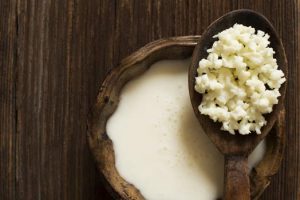 [fusion_dropcap]T[/fusion_dropcap]here are many nutritional and digestive benefits for Ostomates in consuming fermented foods and/or beverages on a daily basis. It has been postulated that the
[fusion_dropcap]T[/fusion_dropcap]here are many nutritional and digestive benefits for Ostomates in consuming fermented foods and/or beverages on a daily basis. It has been postulated that the
lack of fermented foods in our modern day diets may be a contributor to the influx of digestive disorders related to lack of beneficial bacteria in the gastrointestinal tract. The lack of these beneficial bacteria may leave us vulnerable to infection from pathogenic organisms, and make it harder for us to derive some essential nutrients from the foods we eat. Ostomates in particular are often nutritionally depleted due to the illness and/ or surgical and medical procedures which preceded them becoming an Ostomate, and so any interventions that assist nutritional status are beneficial. Even small changes can reap big rewards!
Fermented foods have played a major role in many traditional cuisines but are not considered an essential component of our modern day diet. Prior to industrialisation the Europeans frequently consumed milk in a fermented state as yogurt, cheese, curds and whey, but it wasn’t until the 1930’s that physicians began to notice the healing properties of these foods. Without pasteurisation or refrigeration, milk naturally sours and separates spontaneously. This is due to the process of lacto-fermentation during which lactic acid producing bacteria begin digesting or breaking down both the milk sugar ( lactose ) and milk protein ( casein ). When these beneficial bacteria have produced enough lactic acid to inactivate all the putrefying bacteria, the milk is effectively preserved from spoilage for several days or weeks. In the case of cheese, which undergoes further fermentation of a different type, preservation is sustained for years. Yoghurt is the fermented milk product that we are most familiar with in our modern society.
Kefir is another form of fermented milk that originated in the Caucasus Mountains on the border of Russia. Prior to the 1930’s, the Nobel Prize winning bacteriologist Élie Metchnik off identified that Bulgarians who ingested large quantities of fermented milk enjoyed a longer lifespan than most, and with little to no known disease. Kefi r is prepared by culturing fresh milk with kefir ‘grains’, which bear no resemblance to cereal grains but instead are bacteria and yeast existing in a symbiotic relationship. They have small, soft, gelatinous bodies that resemble tiny, cooked cauliflower florets. Fresh milk is added to the kefi r grains and left at room temperature for approximately twenty-four hours for the milk to ferment. Once fermentation is complete, the cultured milk product is strained to retrieve the kefi r grains for re-use and the process is repeated. Milk kefi r can also be made using a
powdered starter culture. Fermentation of milk results in numerous beneficial changes to the beverage, such as:
- Breaking down the protein in milk (casein), which is one of the most diffi cult proteins to digest. This makes it easier for the digestive system to handle, and is why fermented foods are more easily digested by people who have digestive disorders.
- Reducing the amount of lactose in the cultured milk by as much as 50% and restoring many of the important digestive enzymes that are destroyed during pasteurisation of milk, such as lactase, which helps to digest the lactose that remains in the milk. Therefore many people who are sensitive to milk or have lactose intolerance are able to more
comfortably assimilate the fermented form. - Increasing nutrient quantities such as the levels of B vitamins and vitamin C.
- Releasing nutrients from the food, making them more bio-available for the body to digest and absorb.
Fermented dairy products have the added benefit of introducing beneficial bacteria into the digestive tract, which can help to keep pathogenic bacteria at bay and guard against infectious illness. As such, kefir is referred to as a probiotic beverage. Yoghurt contains two or three strains of beneficial bacteria, but kefir has been found to contain as many as twenty-seven different strains. Therefore, kefir is a much more potent probiotic beverage and so, when introducing fermented milk, it is important to start with yoghurt before transitioning to kefir.
Kefir can also be made from water ‘grains’ immersed in sugar water, juice or coconut water that produces an effervescent, slightly alcoholic beverage that tastes like dry lemonade. The grains used to make water kefir are small, translucent, gelatinous structures comprised of an assortment of bacteria that give them a crystal-like appearance. The process of fermentation produces a variety of beneficial acids, enzymes, B vitamins and benefi cial bacteria whilst also reducing the sugar content.



Fermented vegetables are also popular in traditional cuisines and are similarly produced via a lacto fermentation process that inhibits putrefying bacteria and increases beneficial organisms and nutrients. A bacteria, mould or fungus is often added to the vegetables as a starter culture to begin the fermentation process, but is not always necessary. The benefits are similar to those of fermented milk products in that enzyme levels and digestibility are increased, along with antibiotic and anti carcinogenic substances. Some examples of common fermented vegetables include:
| Sauerkraut | Produced principally from fermented cabbage via the lacto-fermentation process. |
| Kimchi | A traditional Korean fermented food made from a variety of cabbages and chilli. |
| Kombucha | A sugary tea that is fermented to make a fizzy, slightly sour but sweet, mostly nonalcoholic beverage that is low in calories and sugar. It is reported to boost the immune system and detoxify the body |
| Tempeh | A traditional fermented food made from soaked and cooked soybeans inoculated with a mould. After fermentation, the soy beans are bound together into a compact cake. The mould helps to synthesise enzymes that improve the nutritional quality of the food. |
| Miso | A fermented soybean paste made by steaming soybeans and a grain, then adding a fermentation starter and allowing it to sit in cedar vats for eighteen months to two years. Complex proteins, oils and carbohydrates are broken down during the fermentation process into more easily digested nutrients. Miso is a dietary staple in many Japanese cultures. |
Please note that fermented vegetables are not meant to be eaten in large quantities but instead consumed as condiments with a meal. In fact, introducing any form of fermented food or beverage should be done very slowly to allow the digestive system to adjust, and is best achieved under the supervision of a person experienced in the process.
This is because the fermented product introduces beneficial bacteria that may initially ‘fight’ with any pathogenic bacteria present and lead to slight stomach cramps, diarrhoea, nausea or vomiting. These symptoms usually subside after a short period of time. Ingestion of vegetables that have not fermented for at least seven days can also result in bloating and poor digestion in those with sensitive digestive systems. So it is important to assess each case individually as to the degree of imbalance between so called ‘good’ and ‘bad’ bacteria and initiate the process appropriately.
Small quantities of fermented foods or beverages can be made at home in your own kitchen with relative ease, but they require frequent monitoring as the fermentation progresses. I ave some kefir grains that I give to my patients and students, and I do so with the advice that they are like pets in that they need to be monitored and checked every day!
As you can see, there are many benefits for Ostomates in consuming fermented foods and/or beverages on a daily basis. In addition to the extra nutrients that can be derived from these products, they also serve to assist digestion of nutrients that are harder for some people to break down and absorb. The acids that are produced in the fermentation of vegetables and milk can also be of particular benefit to older individuals, as they may aid a digestive system that is becoming more and more feeble. As stated previously, fermented milk in the form of
yogurt or kefir can be suitable for those with lactose intolerance, as the lactose content is lower and the lactace content higher.
However, please note that it is the acids that are produced during the lacto-fermentation process that create this result, so any yogurt in particular consumed
by those with lactose intolerance needs to be very acidic. And, as also stated previously, it is very important to slowly introduce fermented foods or beverages into the
diet.
Wishing you good health and happy days,
Margaret
“Source: Margaret Allan is a qualified Nutritionist (Reproduced from Ostomy Australia, August 2015, P36-37)who advises Ostomates and the general public on diet and health-related matters. Margaret is based in Melbourne and is available for clinical and telephone consultations by appointment. Margaret can be contacted via email on [email protected]”
